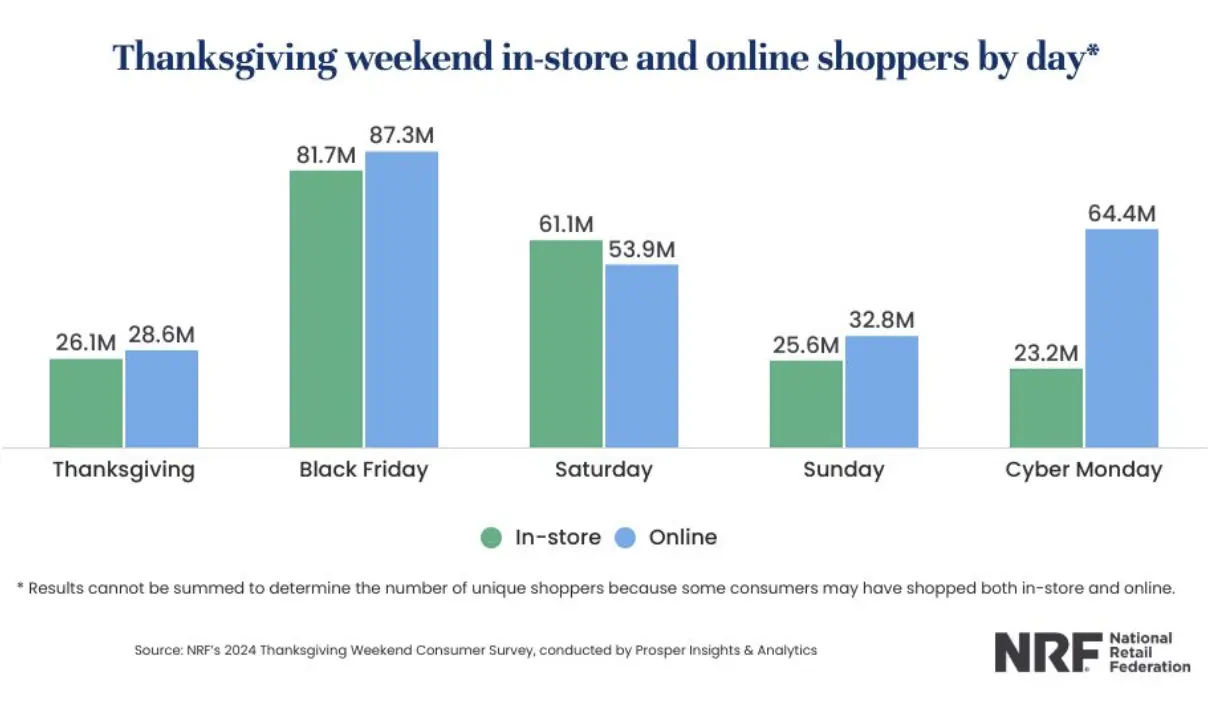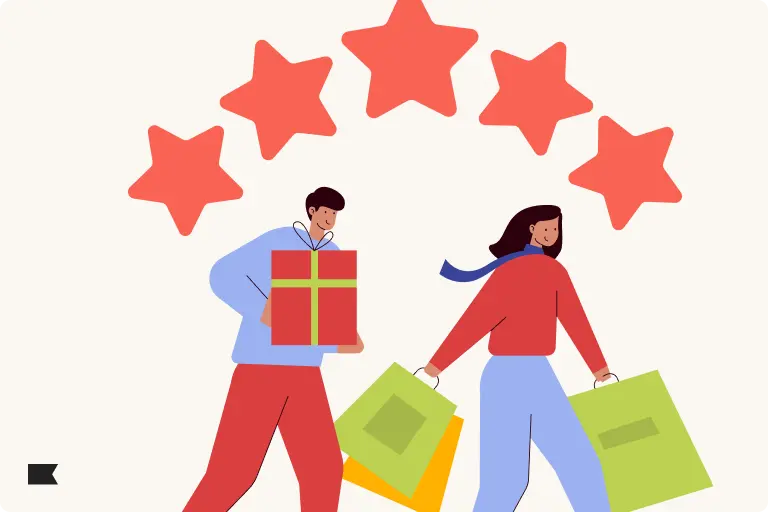11 digital BFCM tactics we already know customers love

Black Friday Cyber Monday, the biggest shopping weekend of the year, has gone digital.
The National Retail Federation confirms it: in 2024, on every day of the holiday weekend except Saturday, more consumers bought online.

“It doesn’t even make sense for me to leave my house on a Black Friday and fight crowds, if there are any,” says Kristen Tumasonis, marketing director at SuitShop.
Zing! And it’s true—lines outside brick-and-mortar stores on Black Friday are increasingly rare. In 2024, foot traffic dropped by 8.2% YoY, according to data from Sensormatic Solutions.
What does this shift mean for marketers?
It means that even for omnichannel brands, digital holiday marketing matters. A lot. In this guide, we walk you through 11 BFCM tactics recommended by in-house marketers, consultants, and agency pros, so you can maximize revenue where modern shoppers actually congregate: online.
1. Providing early access (or an extra discount) to VIPs
POPFLEX has seen success with this approach, offering a password-protected early access holiday sale that lasted 3 hours—reserved for anyone in the top two tiers of the brand’s loyalty program, plus customers who signed up via landing page.
“I think the key message was making people feel special,” says Jen-Ai Notman, POPFLEX’s VP of marketing. “We used a lot of language like ‘You got exclusive access,’ ‘You’re a VIP.’ When the doors opened for them to shop, they felt like they had first dibs. People converted really quickly.”
The key message was making people feel special.
In fact, the first hour of early access was the POPFLEX site’s highest-revenue hour of the year.
Another way to reward loyal customers during the holidays: a VIP discount. With a B2C CRM like Klaviyo that unifies all your marketing, customer service, and analytics data under one roof, it’s easy to create a segment of your most-engaged customers and reward them during BFCM.
As a consumer, Tumasonis always appreciates this. “Even if it’s an extra 5–10% and it’s not going to affect your bottom line too much, I think it is really impactful,” she explains.
It shows that you appreciate your existing customers, even in a season where you’re acquiring a lot of new ones.
2. Partnering with other brands on promotions and sales
Grace Clarke, head of community at Shopify, sees brands supporting each other as a growing trend.
She once created a collaboration-heavy BFCM content strategy with olive oil brand Graza—every single element of their Friendsgiving guide, a compendium of recipes and hosting tips, was created in partnership with another brand.
Partners included keto cereal brand Magic Spoon, herbal seltzer brand Aura Bora, sustainable food container brand Inka, and many more.
“It was very much taking a community-driven approach to Black Friday Cyber Monday,” Clarke explains. “The idea was, why not add another megaphone to this?”
The idea was, why not add another megaphone to this?
Content partners bring in new expertise, Clarke notes, so Graza can publish authoritative pieces on topics outside their brand’s specific niche.
She sees this trend extending into sales, too. Brands can “curate other brands that they know their customers are already shopping elsewhere, or that they think will increase use of their own products and help one-time customers stay,” Clarke explains.
Clarke sees digital cross-selling boutiques popping up on more brand websites during BFCM, monetized via tools like affiliate fees.
3. Incentivizing customers to build a wishlist
POPFLEX has done this with a fall sweepstakes, where customers who submitted a $1,000 wishlist and signed up for email and SMS marketing got entered to win a $1,000 shopping spree. One year, nearly 100,000 people entered.
“The beauty of the wishlist giveaway is it makes the customer engage with your product,” says Notman. “They’re researching, they’re looking at our categories, they’re reading reviews. So we now know the products that they’re interested in, and they have much higher intent going into the holiday season.”
The beauty of the wishlist giveaway is it makes the customer engage with your product.
It doesn’t have to be a giveaway cultivating this kind of intent at scale, either. Any kind of compelling incentive to create a wishlist can have a similar effect, and generate engagement data you can use later to target your BFCM messaging.
Klaviyo B2C CRM makes it easy to store and activate wishlist data, too, with 350+ pre-built integrations with apps like POPFLEX’s preferred wishlist provider, Swym.
4. Offering a generous gift with purchase
Patrick Ta Beauty is a premium brand that doesn’t discount, so for BFCM, they do a different kind of holiday offer: a gift with purchase.
For 8 days including BFCM weekend 2024, customers who spent $150 or more got a gift worth nearly $100 in addition to their purchase: an eyeshadow palette, a lip créme, and a mini tote.
This approach helped customers new and old discover new products, and it also incentivized higher order values. In the end, it helped Patrick Ta Beauty hit their ambitious AOV goals for the holiday season.
5. Building momentum pre-BFCM with limited-edition drops
Shinola, a Detroit-based hand-crafted watch brand, has seen success with this approach. Their holiday event in 2024 ran for almost 4 weeks, and started with daily limited-edition drops and deals—like a one-day discount on a specific watch, or a small-batch collaboration with an up and coming artist.
They communicated these deals primarily via email, amplifying strategic ones with SMS, too. This helped engage their list, create anticipation, and get customers in the habit of checking their website daily.
When BFCM itself arrived, Shinola switched to a spend more, save more sitewide offer, and the momentum they’d already built helped support excellent performance over the weekend: they saw 27% YoY growth in Klaviyo-attributed revenue during the holiday weekend.
6. Personalizing messaging based on quiz responses
Jones Road Beauty leaned into quiz-based segmentation ahead of BFCM, using Klaviyo B2C CRM’s Octane AI integration. This helped them promote their limited-edition holiday mini versions of their best-selling Miracle Balm differently to customers at different stages in their buying journey.
If a subscriber had taken the Miracle Balm Shade Finder quiz but never purchased, for example, they got messaging about trying different shades to find their perfect color. Meanwhile, repeat buyers got more gifting-focused messaging.
“The ease of creating segments in Klaviyo and spinning up personalized emails plays a big part in our BFCM strategy,” says Cody Plofker, CMO of Jones Road Beauty.
The ease of creating segments in Klaviyo and spinning up personalized emails plays a big part in our BFCM strategy.
7. Sending daily (or more-than-daily) marketing emails
Frequency matters, especially when you don’t have an ultra-steep holiday discount, says Tumasonis.
“Stay top of mind,” she advises. “Don’t be scared to send an email every day.”
For example: Little Sleepies sent email campaigns at least daily during BFCM. Some days, they even sent two campaigns—one in the morning to their full list, and one in the evening to people who had engaged with the first email, but hadn’t purchased.
Don’t be scared to send an email every day.
It contributed to a successful holiday weekend: they more than doubled their BFCM revenue from email YoY.
Including an element of personalization with this tactic can go a long way, too. If a subscriber clicks on pajama sets in your first email, for example, send them similar recommendations in the follow-up.
8. Sending a lot—but not to everyone
Patrick Ta Beauty increased email send volume nearly 6x YoY during BFCM—without spiking unsubscribes. Their unsubscribe rate actually dropped 37% YoY during the holiday.
How did they do it? The key was that they didn’t ramp up sends to their entire list. Instead, they excluded recent purchasers from communications about their holiday promotion, across email and SMS.
Avoiding irrelevant messaging helped the team boost send volume and Klaviyo-attributed revenue—up 8x YoY—in an efficient, sustainable way.
9. Running hybrid abandonment flows, plural
Before BFCM 2023, POPFLEX integrated SMS into 3 of their abandonment flows—for browse, cart, and check-out abandonment.
It meant SMS subscribers got mobile-native reminders to complete their purchase before the sale’s end.
This helped generate major revenue lift—POPFLEX’s revenue from automations during their 8-day BFCM sale jumped 3.3x YoY, and their revenue from SMS during their sale grew 172% YoY.
“SMS is a really interesting emerging marketing channel,” Notman says. “It’s the future—it’s where people are and it’s the device that they’re on.”
SMS is where people are. It’s the device that they’re on.
During BFCM, it’s also a great re-engagement channel, points out CJ Palmer, implementation consultant at Klaviyo.
“If someone clicks and then abandons earlier in the day, send them an SMS later as part of the abandonment flow to drive more conversions,” Palmer suggests. “We sometimes view SMS with kid gloves, but it’s important to remember that these people subscribed, so we should feel empowered to text them.”
10. Taking a proactive approach to support
Last year, Tumasonis had an amazing experience with customer service at Cay Skin that guaranteed she’d buy from them again.
She placed an order over BFCM, and the shipment was delayed—though not so much that it arrived after Christmas.
The brand apologized for the delay and sent her a $20 coupon. Then, in March, they followed up with another apology: a full-size free product and another coupon code.
It’s particularly easy to distribute these types of coupon codes with Klaviyo B2C CRM tools like Customer Hub, a personalized, signed-in account experience that lets customers access their coupons without leaving the Shopify site.
These special touches are worth it, too: Cay Skin impressed Tumasonis by “proactively getting ahead” of negative sentiment around the delay, and going “above and beyond in terms of making me a fan again.”
“I will 100% shop with them again,” she adds.
11. Sending a last-minute offer to active-on-site shoppers
Maternity and baby boutique Caden Lane took an interesting approach to final-hours messaging during BFCM: they sent out a last-minute discount to customers currently active on their site who hadn’t yet purchased.
“That one email pushed us over the finish line,” says Caden Lane CMO Bryant Jaquez. The boutique hit their revenue and margin goals for the holiday.
Get ready for the holiday rush where it happens—online
It’s not just Cyber Monday anymore. The whole BFCM weekend is now digital-first.
You can’t surprise and delight customers with epic in-store holiday displays or bargain basement doorbuster deals. Today, doorbuster deals are most likely discount codes sent out via email, anyway.
But online BFCM is winnable. You just need to start planning early, build on what’s already performing well for your brand, and take a few big, creative swings—like a free gift, or an all-new custom email design.
If you’re a marketer, ’tis the season to hit your goals and sharpen your competitive edge.
Black Friday marketing FAQs
How do you create urgency and drive more sales for Black Friday?
Embed countdown clocks in your emails, and send out final-hours messaging to customers who’ve engaged with your sale emails, but haven’t yet purchased.
For extra urgency, you could try a series of shorter-term deals, instead of a constant multi-day sale. More final hours to count down to!
How do you plan for increased website traffic during Black Friday?
Use Google’s PageSpeed Module to identify elements slowing down your site’s load speed, like too-big images—and optimize pop-up and sign-up modules in advance, to maximize your odds of staying in touch with visitors that don’t convert right away.
How do you track and measure the success of Black Friday marketing campaigns?
Look at YoY growth in holiday revenue, but also track your margins, monitoring coupon code redemption and average discount rate.
You’ll also want to track how customers who bought during Black Friday—especially for the first time—behave during the year ahead. If they’re coming back again and again, it can justify lower—or slightly negative—BFCM margins.

Related content

Learn about 11 Valentine’s Day marketing ideas that can boost Q1 revenue and gather customer data to take you into the rest of the year.

Learn 5 ways to turn new holiday shoppers into repeat buyers using personalization, seamless returns, targeted outreach, and AI-driven customer experiences.

Learn what to include in your photography style guide to create consistent, on-brand visuals across your B2C marketing channels.
